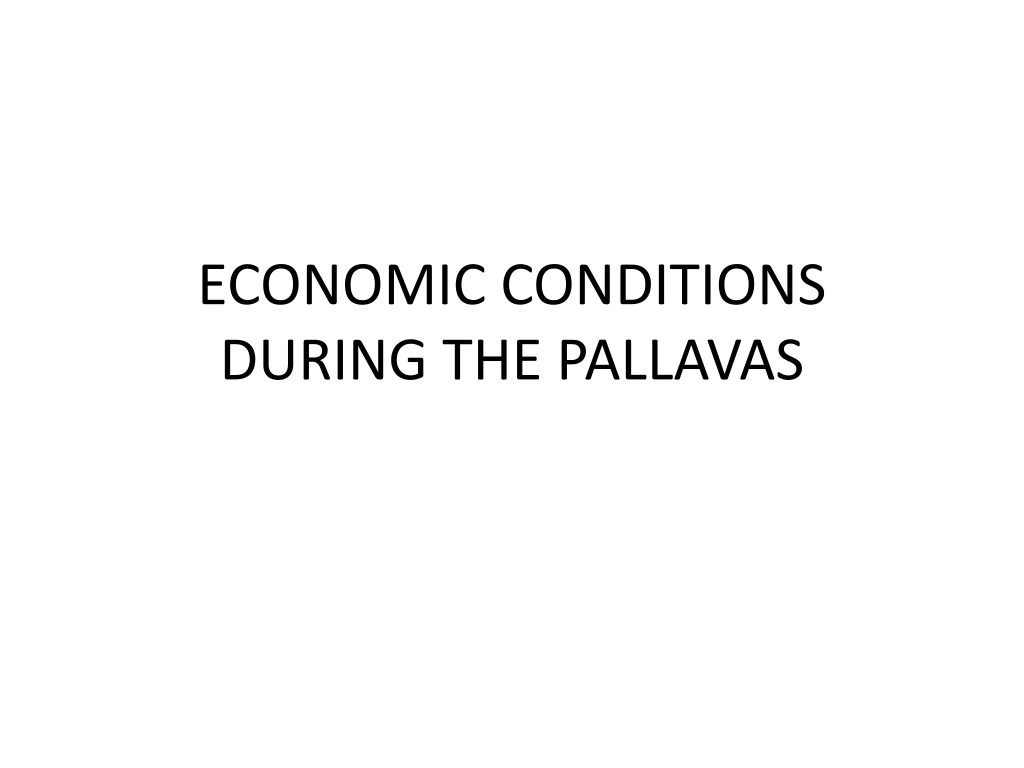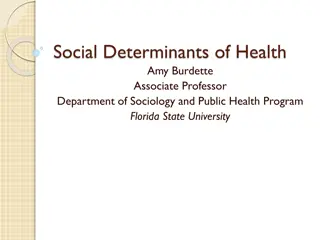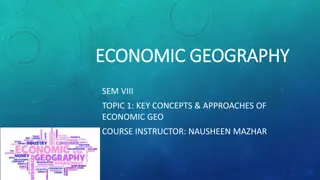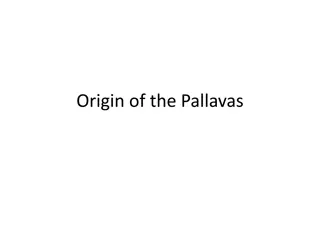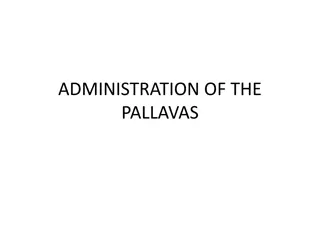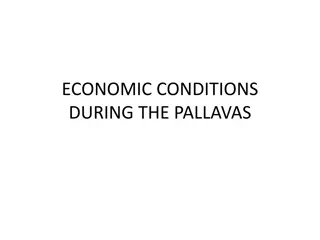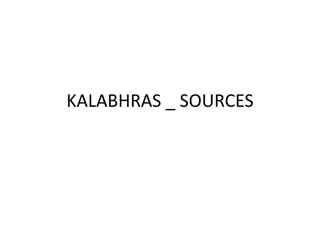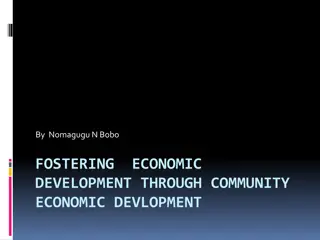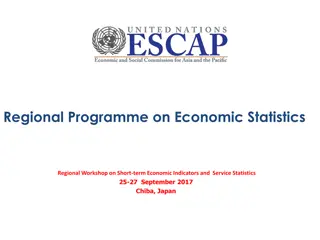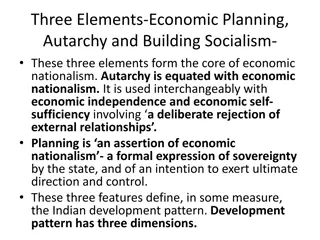Economic Conditions During the Pallavas
The economy of the Pallava Kingdom was primarily based on villages and agriculture, with crops like paddy and cotton extensively cultivated. The period saw the development of Brahmadeya villages, increased village numbers, and the emergence of important trade centers like Kanchipuram. Internal and foreign trade flourished, with the Pallavas issuing coins and measuring units for trade activities. Craftsmanship thrived, including weaving, stone cutting, pottery, carpentry, and ivory works. Religion under the Pallavas saw a revival of both Saivism and Vaishnavism.
Download Presentation

Please find below an Image/Link to download the presentation.
The content on the website is provided AS IS for your information and personal use only. It may not be sold, licensed, or shared on other websites without obtaining consent from the author.If you encounter any issues during the download, it is possible that the publisher has removed the file from their server.
You are allowed to download the files provided on this website for personal or commercial use, subject to the condition that they are used lawfully. All files are the property of their respective owners.
The content on the website is provided AS IS for your information and personal use only. It may not be sold, licensed, or shared on other websites without obtaining consent from the author.
E N D
Presentation Transcript
ECONOMIC CONDITIONS DURING THE PALLAVAS
ECONOIC LIFE Agriculture . The economy had remained self sufficient of the Pallava Kingdom was chiefly based on Villages and agriculture Paddy and Cotton were extensively cultivated . Rice was exported to China and East Indies . The creation of the Brahmadeya villages had started during the Pallava period . The Brahmins began to settle in these villages and they were exempted from paying taxes. The Lands donated to the temples were called as Devadanas . The number of villages had increased during the Pallava rule .
There were two types of lands __ Cultivable Lands and Arid Lands Arid lands were reclaimed and cultivated . The Pallava kings had erected sevesral irrigation Tanks The pallava ruler Mahendravarman I erected the Mamandur Tank called Chitra Mega Tadakam . Handicrafts . The Crafts of the Pallava period include Weaving , Stone Cutting , Pottery , Carpentry and Ivory Works , The Cotton Clothes were exported to China , Babylonia and Egypt . Kanchipuram had remained an important centre for Silk Weaving .
Internal Trade The increase in production and the expanding economy under the Pallavas led to the growth of Trade . There was a remarkable growth in the internal trade . The regular markets had gradually become urban centres . There were excellent highways to transport goods from one place to another . The Capital city , Kanchipuram had remained an important trading centre . The merchants of the Pallava period had to obtain license to keep shops and they were also asked to pay taxes . The Pallavas had issued Gold and Silver Coins , which had resulted in the expansion of commerce . The merchants had formed their own organizations called Manigramam .
Foreign Trade . Spices , Cotton Textiles , Precious Stones and Medicinal Plants were exported to the countries like Java , Sumatra , Kadaram , Combodia , Sri Lanka , China and Burma . The foreign merchants were known as Nanadesi Mamallapuram and Mylapore were the important seaports of the Pallavas . Weights and Measures . Lands were measured with the units called Uzhavu, Nivarthanam or Pattiga and Hala refers to the unit of land . Plough was used for measuring the land . Paddy and Rice were measured by Chudunazhhi . The other units such as Videl , Vidugu and Uzhkku were also used for measurement . Pidi was the smallest unit .
The units such as Aazhakku , Uzhakku , Uri and Nazhi were used to measure items like Milk , Ghee , and Oil . Gold was measured by the units called Kazhanju and Manjadi . _____
Religion under the Pallavas . During the Pallava period , both Saivism and Vaishnavism had been revived , The Pallava rulers patronized both these religions . The spread of Bhakthi Movement was encouraged by the Pallava rulers . Bhakthi Movement . The Bhakthi Movement , which had spread in South India during Sixth and Seventh centuries AD , made a tremendous impact in the Social and Cultural life of the people . The term Bhakthi means Devotion to God . True Bhakthi was considered as more valuable than mere rites and rituals . During the period of Pallavas Alzhwars and Nayanmars preached the cult of Bhakthi among the people .
Saivism . The followers of Lord Siva were known as Saivaites , the saiva Saints , Nayanmars had preached Saivism . There were Sixty Three Nayanmars , the most important among them were Tirunavukkarasar , Thirugnanasambandar Sundarar and Manickavasagar There was also woman saints like Karaikkal Ammaiyar . They composed devotional songs and spread Bhakthi among the minds of the people . The hymns of Nayanmars have been compiled into Panniru Thirumurais
The hymns composed by first three were called Thevaram . Manickavasagar composed Thiruvasagam . Vaishnavism . The devotees of Lord Vishnu were called Vaishnavaits . Azhwars preached Vaishnavism during the Pallava period . There were twelve Azhwars Poigai Azhwar , Pey Azhwar , Bhoothath Azhwar , Thirumalisai Azhwar , Thirumagai Azhwar . Nammalwar , Periyazhwar , Thirupanazhwar , Madhurakavi Azhwar , Kulasekhara Azhwar , and Andal
The only woman among the twelve Azhwars was Andal , composed Thiruppavai and Nachiyar Thirumozhi . The Hymns of Alwars have been compiled into Nalayira Divya Prabandam . Both Saivism and Vaishnavism had become popular among the people due to the spread of the Bhakti Movement . Alwars and Nayanmars had composed their songs in Tamil and contributed to the growth of Tamil Literature . ________.
Art and Architecture under the Pallavas Introduction The Pallavas were the pioneers of South Indian Art and Architecture . They had introduced the Stone Architecture in the Tamil Country . Their Architecture had evolved stage by stage fro the period of Mahendravarman -I Their Architecture was classified as 1. Rock Cut Temples 2. Monolithic Rathas and Sculptural Mandapas and 3. Structural Temples
Rock Cut Temples : The Pallava Rock cut Temples as Mahendravarman Style . He carved temples out of the rocks and thus they were known as rock cut temples . It was an really an innovation in the sphere of Art because he did not use any other building materials . Therefore , he was hailed as Vichitra Chitta . In these Rock cut Temples , we find the Sanctum and Sanctorium and on the Walls of it beautiful Sculptures . The Pillars are carved in such a way thst they stand on the heads of lions . The Rock cut Temples of Mahendravarman -I are found at various places of Tamil Nadu The most among them are Pallavaram , Mamandur , Mahendravadi Vallam and Thalavanur .
Monolithic Rathas : The Monolithic rathas and Sculptural Mandapas costitute the Mamalla Style of Architecture . The Pallava king , Narasimhavarman -I was known as Mamalla . He had converted the port of Mamallapuram as a beautiful city of Art and Architecture . The Monolithic Rathas at Mamallapuram are now called as Pancha Pandava Rathas . Each Ratha or Chariot was carved out of single rock and hence the name Monolithic . The Mandapas or Halls at Mamallapuram had also belonged to the Mamallan period . Each Mandapa was carved out iof single rock . On the side walls of these Mandapas , beautiful Sculptures depicting Puranic stories had been carved .
The most important among the Mamalla Style of Architecture is the Open Art Gallery . And Several Miniature Sculptures have been carved beautifully on the wall of a big rock . The fall of the River Ganges from the head of God Siva and the Arjuna s Penance are notable among them . The image of Deer , Monkey , Cat , Mouse , and other animals are beautifully carved on this huge rock . Structural Temples . From the reign of Rajasimha , the construction of Structural temples were started . These temple structures were built with the use of Granite Slabs , known as Structural temples .
The Structural Templee were classified into Rajasimha Style and Nandivarman Style The earliest among the Pallava structural temples were the Kailasanatha Temple at Kanchipuram and the Shore Temple at Mamallapuram , were built by using Sandstones and also filled with numerous sculptures .. This temple is considered as the Crown of Pallava Architecture . The Sculptures depicting the Scenes of the Drama of Mathavilasa Prahasanam have been engraved in this temple . Nandivarman -II had built the Vaikunda Perumal Temple at Kanchipuram . The Temples built by the later Pallava rulers are found at places like Kanchipuram , Tiruthani and Gudimallam .
Fine Arts : The Pallava kings had also patronised fine arts . The Kudumianmalai and Thirumayam music inscriptions show their interest in music . Yaazhi , Mridangam and Murasu were some of the musical instruments of the Pallava period . Both Mahendravarman -I and Narasimhavarman I had remained experts in music . Chittannavasal illustrate the nature of Pallava painting . mahendravarman I was known as Chittirakkarapuli composed the book , Thatchina Chitram . He was the author of the drama Mathavilasa Prakasanam . Music , Dance , Paintings and Drama were popular during the Pallava rule. _______.
Music , Dance , Paintings and Drama were popular during the Pallava rule .
